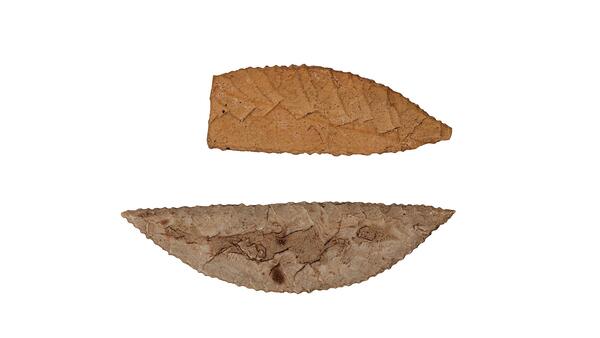The stone knives from the Museum of Local History collection were found in 1952 during the Glazkovsky necropolis excavations — the largest Neolithic era cemetery in North Asia. It was discovered in Sverdlovsky city district of Irkutsk. Most of the Glazkovsky necropolis is called the Lok the ‘Lokomotiv’ Early Neolithic Cemetery. It was so called because the burials were found under a stadium.
Many Irkutsk archaeologists of different generations took part, working at the archaeological site: Nikolai Vitkovsky, Mikhail Ovchinnikov, Pavel Khoroshikh, Mikhail Gerasimov, Vladimir Bazaliysky and others. Scientists have been exploring the necropolis for more than 130 years and have unearthed 87 Neolithic graves with skeletons of 140 buried people, as well as many household and ritual objects. There were stone knives among them, which were donated to the museum by Pavel Khoroshikh.
Items, found by archaeologists in the graves, are useful tools which, according to an ancient tradition, were necessarily placed in the graves. And so, the buried people were equipped for the afterlife. The objects visual design, sizes and materials, from which they were made, differed depending on the region and traditions.
Art objects, hunting and fishing tools, as well as knives were often placed in graves in Siberia. In the Neolithic era, people used flake knives — the edge was carefully processed, and they were as sharp, as the steel ones. The handles of the tools found by archaeologists were not preserved, and the blades had many variations. Therefore, scientists used the term ‘knife’ for all stone findings with an elongated shape and a sharpened edge.
The ‘Lokomotiv’ Early Neolithic Cemetery, where the artifacts were discovered, was located right in the center of Irkutsk. Most of the ancient artifacts were destroyed due to the construction of the railway in the late 19th — early 20th century. And all excavations taking place at the Lokomotiv cemetery in the following years became emergency rescue operations before new buildings were built or city communications were laid. Now the Service for the Protection of Cultural Heritage objects of the Irkutsk region is monitoring the site’s territory. A museum is soon to be established on the site of the Glazkovsky necropolis.
Many Irkutsk archaeologists of different generations took part, working at the archaeological site: Nikolai Vitkovsky, Mikhail Ovchinnikov, Pavel Khoroshikh, Mikhail Gerasimov, Vladimir Bazaliysky and others. Scientists have been exploring the necropolis for more than 130 years and have unearthed 87 Neolithic graves with skeletons of 140 buried people, as well as many household and ritual objects. There were stone knives among them, which were donated to the museum by Pavel Khoroshikh.
Items, found by archaeologists in the graves, are useful tools which, according to an ancient tradition, were necessarily placed in the graves. And so, the buried people were equipped for the afterlife. The objects visual design, sizes and materials, from which they were made, differed depending on the region and traditions.
Art objects, hunting and fishing tools, as well as knives were often placed in graves in Siberia. In the Neolithic era, people used flake knives — the edge was carefully processed, and they were as sharp, as the steel ones. The handles of the tools found by archaeologists were not preserved, and the blades had many variations. Therefore, scientists used the term ‘knife’ for all stone findings with an elongated shape and a sharpened edge.
The ‘Lokomotiv’ Early Neolithic Cemetery, where the artifacts were discovered, was located right in the center of Irkutsk. Most of the ancient artifacts were destroyed due to the construction of the railway in the late 19th — early 20th century. And all excavations taking place at the Lokomotiv cemetery in the following years became emergency rescue operations before new buildings were built or city communications were laid. Now the Service for the Protection of Cultural Heritage objects of the Irkutsk region is monitoring the site’s territory. A museum is soon to be established on the site of the Glazkovsky necropolis.



